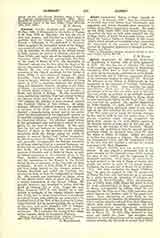

Albert (ALBRECHT) II, eighteenth Archbishop of Magdeburg in Saxony, date of birth unknown; d. 1232. He was the son of Gunther III, Count of Kevernburg, and began his studies at Hildesheim, completing them later at Paris and Bologna. At an early age he was made a prebendary of the Magdeburg cathedral, and in 1200 was appointed Provost of the Cathedral Chapter by Innocent III. Through the influence of the Bishop of Halberstadt, he was nominated as the successor of Ludolph, Archbishop of Magdeburg (d. 1205). After receiving the papal approbation, which was at first withheld, partly on account of those who had taken part in his election and partly on account of his attitude towards Philip of Suabia, Albert proceeded to Rome, where he was consecrated bishop by the Pope (December, 1206) and received the pallium. He entered Magdeburg on Palm Sunday, April 15, 1207, and five days later a conflagration destroyed many of the buildings of the city, including his own cathedral. One of his first cares was to repair the damage wrought by fire, and in 1208 he laid the cornerstone of the present cathedral, which, though completed 156 years later, serves as his most fitting memorial. He likewise rebuilt a large part of the city, and is regarded as the founder of the Neustadt. Magdeburg was also indebted to him for several valuable privileges which he obtained from Otto IV after the death of Philip of Suabia. Albert did much to further the interests of religion. He established the Dominicans (1224), and the Franciscans (1225) in the city, and also founded a convent for women in honor of St. Mary Magdalen.
But Albert‘s activity was not confined to his diocese. He also played a prominent part in the great struggle for the imperial crown, which marked the close of the twelfth and the beginning of the thirteenth centuries. Even before his consecration, he had inclined to the side of Philip of Suabia, who sought the crown in spite of his young nephew Frederick, the son and heir of Henry VI (d. September 28, 1197). But later, accepting the papal “Deliberation”, he gave his support to Otto IV, second son of Henry the Lion, who had been set up as antiking by a party headed by Adolphus of Cologne and crowned at Aix-la-Chapelle. After the assassination of Philip (July, 1208) Albert did much to have his rival acknowledged as king. Otto proceeded to Rome, accompanied by Albert, where he was crowned by the Pope on October 4, 1209, and soon after seized Ancona and Spoleto—part of the papal territories. Upon attempting to enter Sicily he was excommunicated by Innocent III (Maundy Thursday, 1211), and his subjects released from their allegiance. Albert, after some hesitation, published the bull of excommunication and thenceforth transferred his allegiance to Frederick II, the Hohenstaufen, son of Henry VI. In 1212 Otto returned to Germany and defied the Pope. The struggles that followed, in which Magdeburg and its neighborhood suffered severely, did not come to an end until Otto’s power was broken at the battle of Bouvines (1214). Albert is said to have died in 1232 during an interval of peace between the Empire and the Papacy.
H. M. BROCK

